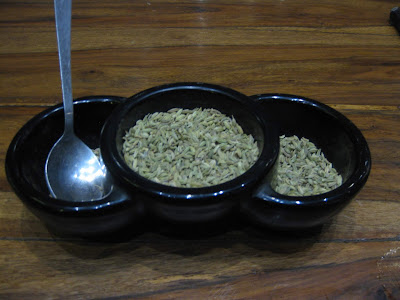 |
| Selecting a goat for one of the annual feasts in Nepal. |
Flying into Nepal, I had a big question mark on my mind as to the food. I had studied up on the place beforehand, including what people ate, but even so, couldn't quite orientate my taste buds in that direction. The ingredients, even the names, were too exotic or something.
Dal Bhat, for instance, the signature dish of the land. But what the heck is that? Dal Bhat? Here is one definition:
Dal Bhat, for instance, the signature dish of the land. But what the heck is that? Dal Bhat? Here is one definition:
Dal Bhat: a traditional meal originating in the Indian subcontinent, popular in many areas of Nepal, Bangladesh, and India. It centers around steamed rice or Bhat and a cooked lentil soup called Dal. Depending on the region and the season of the year, various side dishes complement. Often served on elegant brass or silver sets.
I didn't realize it when I stepped off that airplane, I was about to experience one of the ultimate dishes for travelers...
 |
| A typical Dal Bhat...250 Rupees ($2.15 U.S.) |
From left to right on the plate: sauteed green beans and potatoes, steamed spinach, steamed rice, and mini-French fries. The goblets contain lentil soup on the right and goat meat in curry on the left. At top is a large corn chip and sliced cucumber.
What this added up to is a balanced meal, something that can be hard to find in some places when you're bouncing around the back country. Heck, it can be hard to find in the Land of Burgers and Fries, the U.S.!
But in Nepal it's seemingly everywhere, everyday...and the ingredients vary depending on the season and what's being grown in that locale. So it doesn't get boring. You roll into a new town and it's a mini-adventure for the palate as to what's being served up. Meanwhile the basic formula remains the same.
All this by way of saying, three cheers for Dal Bhat!
 |
| Popular saying in Nepal. |
 |
| Lots of freshness at the marketplaces -- tomatoes, cauliflower, greens, etc. |
While coffee is consumed there in good measure, Nepal is generally a tea drinking country. Most Nepalis start their day light -- a cup of masala or spicey milk tea and some kind of baked good. Later in the morning they'll eat a hearty brunch, say at 10 or 11 in the morning.
The brunch often is in the style of Dal Bhat, only with eggs and maybe bread instead of the lentils and rice. And it's just as good, as far as I'm concerned, and nutritious as well...
 |
| Start off with the Himalayan Times and a cup of masala tea |
 |
| Later on -- a rolled-up omelet with curry vegetables and salsa-like condiment... |
 |
| Or maybe go the roadhouse breakfast...this one for 200 Rupees ($1.75 U.S.), with ginger tea. |
Sometime between brunch and dinner, maybe you want a snack, something small. Give a try to some Mo-Mos. Nepal is known for them.
They're on the order of dumplings with a filling of buffalo, chicken or vegetables, your choice. In general I found them tasty, but rather on the greasy/oily side. Squeeze one and you could lube up a rusty hinge with what oozes onto your palm!
So I'm glad I had them a few times, but wouldn't want them as a staple. Nonetheless, these are one of the top restaurant offerings in Nepal...
John Lennon's song, "Give Peace A Chance," could be an anthem here in Nepal. There's so many shops, restaurants, guest houses, etc. using peace for a theme in one way or another. Below are a few examples...
 |
| Restaurant in Bhaktaphur. Note woodcarving, which the city is known for. |
 |
| Your humble correspondent, ready for the dusty streets of Kathmandu. |
 |
| Many eateries vying for vegans and vegetarians. |
And let's not forget the soups. Nepal has some of the best that I've had in Asia or anywhere for that matter. Simple, hearty and tasty. Here's one of the most popular...
Having finished eating a Dal Bhat one evening, I was sitting in a restaurant in Kathmandu and gestured to the waiter to get my check. To my surprise, he approached and asked, "Would you like to finish the meal, sir?"
Finish the meal? I wondered. What the heck does he mean by that? Desert or something?
He held out a set of bowls containing seeds. In Nepalese they're called simply "sup," Also known widely as anise or aniseed. He explained that you don't toss back a handful, like say with peanuts. Rather, you take a pinch and nibble on them like a chipmunk does a morsel, savoring the flavor. This aids in the digestion and leaves a pleasant aftertaste, with a hint of licorice. Thus the phrasing used there, finishing the meal.
Speaking of finishing things, this does it for my series of travelogues on Nepal. As I've stated throughout, the country was difficult to get around, often dirty and dusty, the roads hellish. But considering the culture, the food, etc., one of the most fascinating places I've ever visited.
With that in mind, and if you have the urge to go, I'd say go for it. If nothing else, the scenery and the people were wonderful.
Thanks to those of you who followed along through all four of these. Happy Holidays and happy travels, wherever they may take you!
| Nepalese flag |
[END OF SERIES ON NEPAL]










































